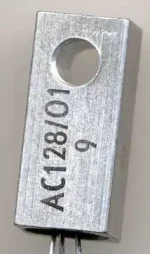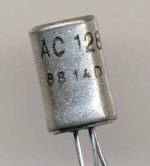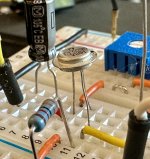gtfields13
Well-known member
I think the answer is, not much...
I've been breadboarding the standard fuzz face circuit (see ElectroSmash Fuzz Face) with trim pots in place of R3 and R4, in advance of committing to solder on the PedalPCB Twin Face pcb. What I've been finding is that, when I iteratively adjust R3 and R4 to set the Q2 Collecter bias to -4.5 V and Q1 Collector/Q1 Base to -0.7 V, I can't hear any differences amongst my GE transistors, Russian GT309, MP21, MP26, or a salvaged Hitachi 2SB75. This includes changing either Q1 or Q2 from 40 hFE to 150 hFE. I do find that trimming R4 is what really makes a difference for setting the Q2 collector bias point, and R3 is more of a fine adjustment that helps me dial in Q1 collector. Interestingly (or not - probably reflects a fundamental attribute of the circuit and a gap in my ChEng eduction), when these two points are at the nominal targets, the other test points (Q1 Base, Q2 Emitter) are exactly -0.2 V and -0.5 V, as in the Electro Smash analysis.
I've been recording at a couple of set guitar volume and fuzz settings, and truly don't hear anything in A/B comparison.
The only thing that made a difference was swapping in a silicon PNP (2N4403).
This seems consistent with a comment I read that biasing really matters more than the transistor gain. Which makes me think I can a lot more Fuzz Face out of the lower (40-60) Ge in my stash without obvious changes in performance. It also makes me understand that, in addition to the usual bias pot at R3 (as in the Twin Face design) I am going to want to adjust R4 in each builds to suit the transistor.
I've been breadboarding the standard fuzz face circuit (see ElectroSmash Fuzz Face) with trim pots in place of R3 and R4, in advance of committing to solder on the PedalPCB Twin Face pcb. What I've been finding is that, when I iteratively adjust R3 and R4 to set the Q2 Collecter bias to -4.5 V and Q1 Collector/Q1 Base to -0.7 V, I can't hear any differences amongst my GE transistors, Russian GT309, MP21, MP26, or a salvaged Hitachi 2SB75. This includes changing either Q1 or Q2 from 40 hFE to 150 hFE. I do find that trimming R4 is what really makes a difference for setting the Q2 collector bias point, and R3 is more of a fine adjustment that helps me dial in Q1 collector. Interestingly (or not - probably reflects a fundamental attribute of the circuit and a gap in my ChEng eduction), when these two points are at the nominal targets, the other test points (Q1 Base, Q2 Emitter) are exactly -0.2 V and -0.5 V, as in the Electro Smash analysis.
I've been recording at a couple of set guitar volume and fuzz settings, and truly don't hear anything in A/B comparison.
The only thing that made a difference was swapping in a silicon PNP (2N4403).
This seems consistent with a comment I read that biasing really matters more than the transistor gain. Which makes me think I can a lot more Fuzz Face out of the lower (40-60) Ge in my stash without obvious changes in performance. It also makes me understand that, in addition to the usual bias pot at R3 (as in the Twin Face design) I am going to want to adjust R4 in each builds to suit the transistor.



